#Jesus the Stone Mason
Explore tagged Tumblr posts
Text


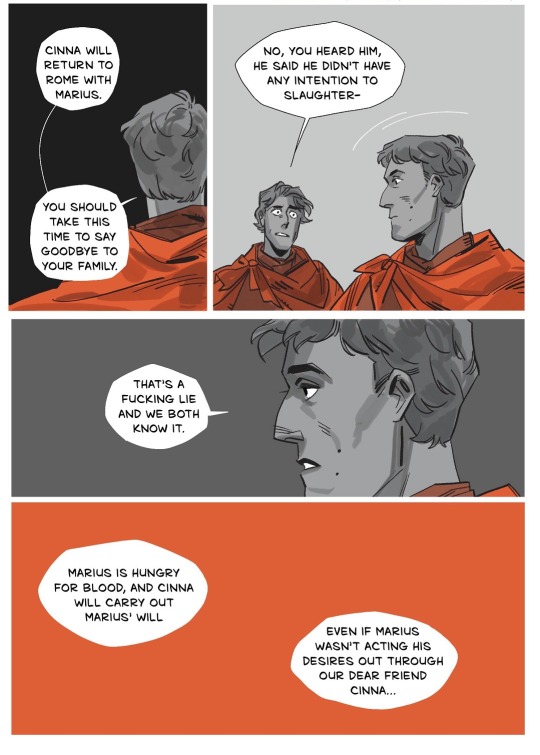
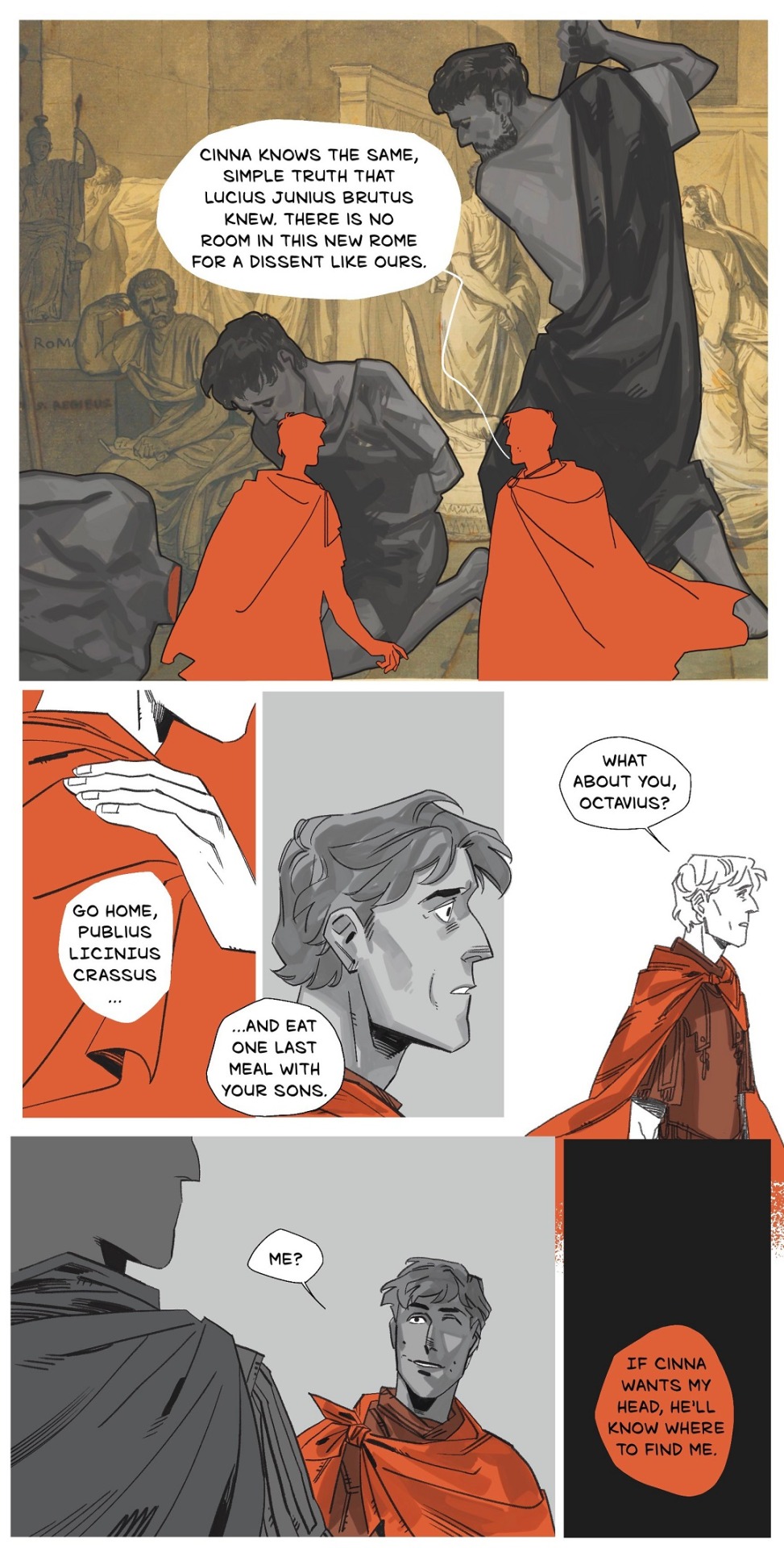
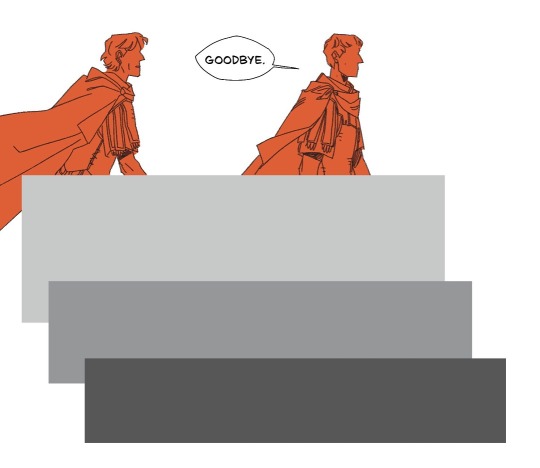
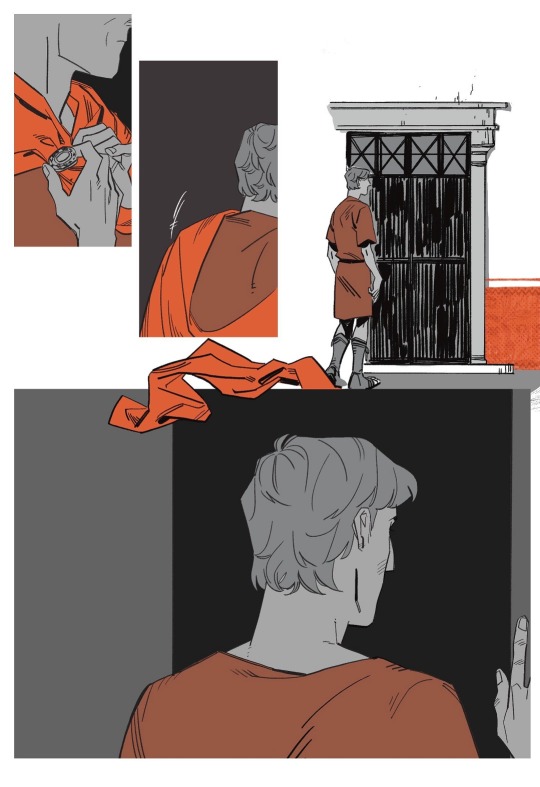
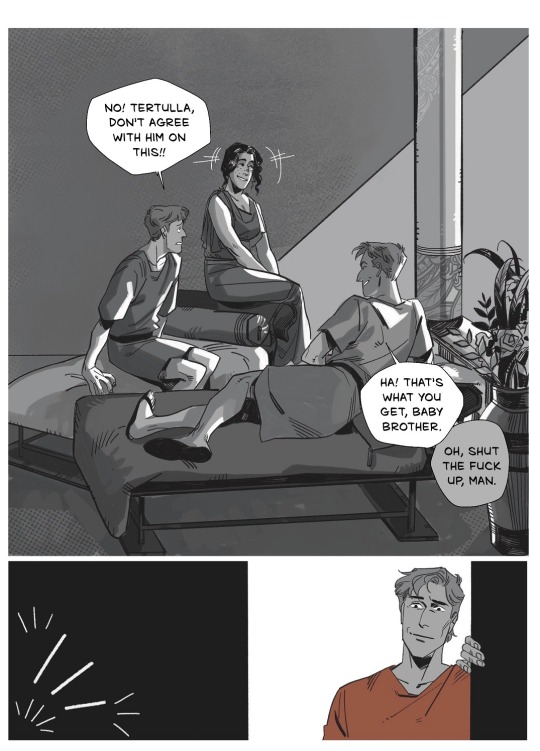
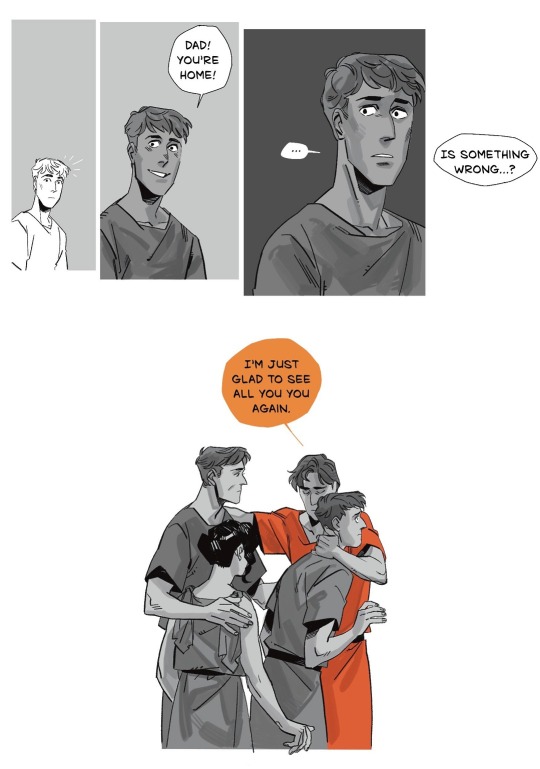
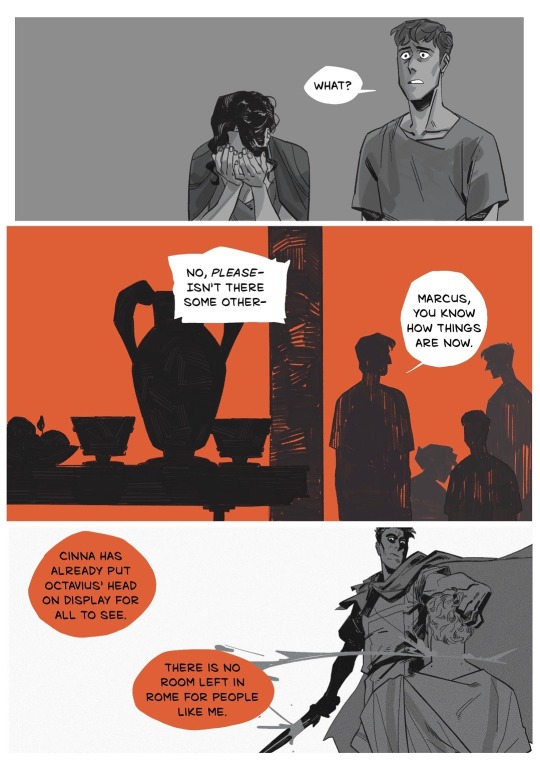
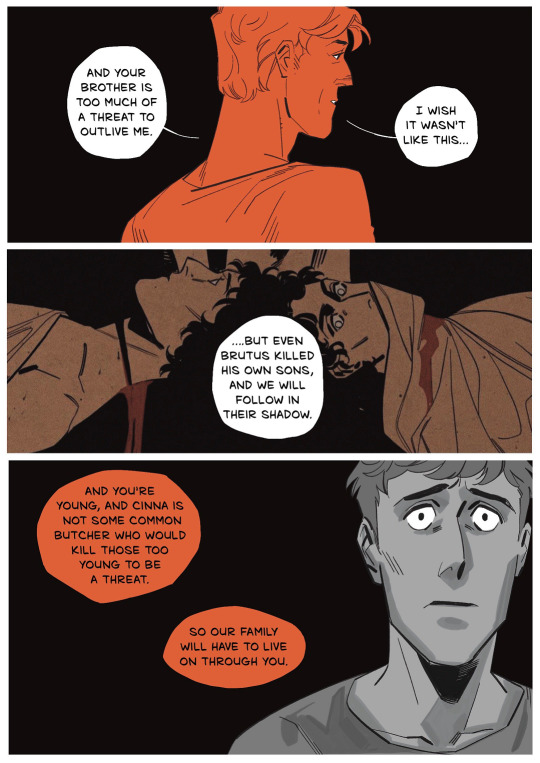
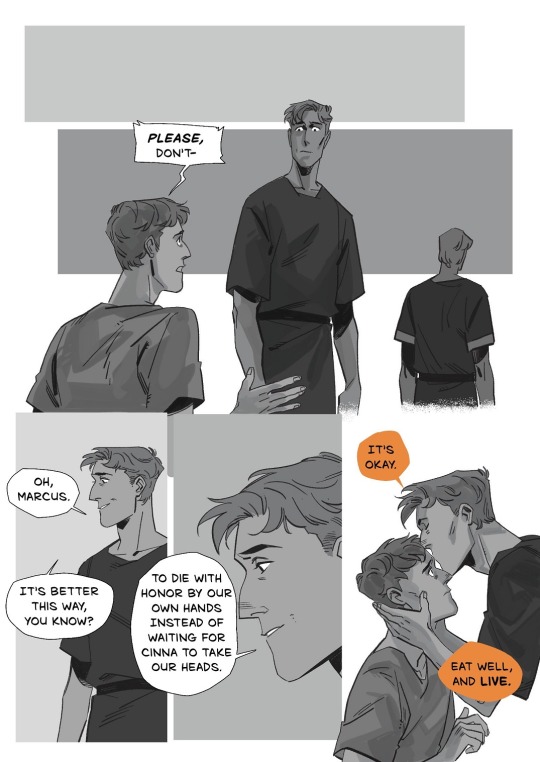
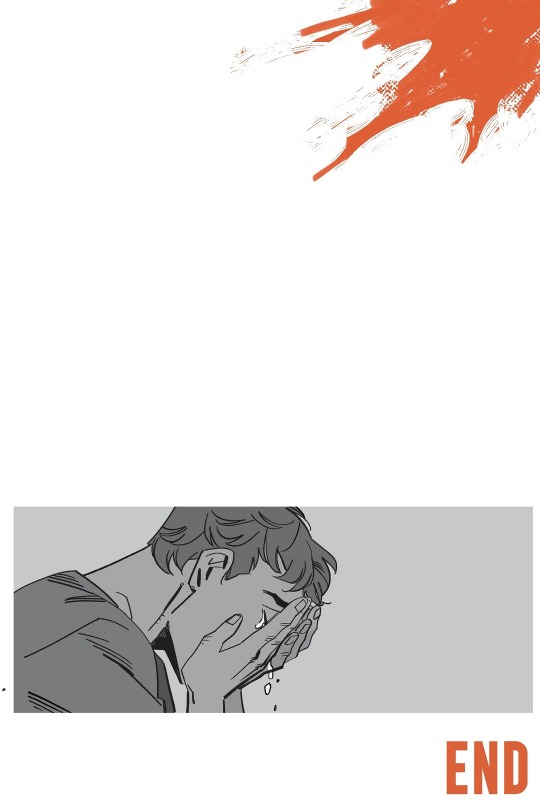
TRIKARANOS CHAPTER I: S·T·T·L
TRIKARANOS is a comic about Crassus until it isn't. Intended for an adult audience.
⭐ Trikaranos will always be free to read. In the near future, you’ll have the option to support this comic & my ability to spend time making it (I Am Extremely Fucking Broke And Have Bills To Pay etc etc) through Patreon! currently, I have a tip jar!
⭐ There is no set update schedule (chapters vary in length and will be posted as I finish working on them)
⭐ alternative places to read it (coming soon!)
CREDITS all additional art used are in the public domain, and the specific images used are open access, etc
🍊the first collage panel is combination of: Plate 113: Greeks Battling the Trojans (from Ovid's Metamorphoses), Antonio Tempesta / The Trojans pulling the wooden horse into the city, Giulio Bonasone (after Francesco Primaticcio) / Terracotta hydria displaying Achilles waiting to ambush Triolos and Polyxena 🍊the second collage panel is: The Lictors bringing Brutus the bodies of his Sons, Jacques Louis David / the paint over of Brutus executing is own sons is my own work based on the composition of this relief of Brutus and condemning his sons to death. 🍊I also used my own art: a panel from the Prologue, and my own illustration of Brutus with the bodies of his sons
📖 PREVIOUS CHAPTER | START HERE | ToC (under construction!)
UNDER THE CUT creator’s commentary, ancient citations, whatever else seems relevant. ideally, this is optional! you shouldn’t need the citations for it to make sense as it unfolds since it’s a comic and a story first and foremost, but it’s here if you’re curious about something or want to see where the inspiration is coming from!
I'm so fucking normal about Crassus and his family (<<< this is a lie)
Marcus Crassus was the son of a man who had been censor and had enjoyed a triumph; but he was reared in a small house with two brothers. His brothers were married while their parents were still alive, and all shared the same table, which seems to have been the chief reason why Crassus was temperate and moderate in his manner of life. When one of his brothers died, Crassus took the widow to wife, and had his children by her, and in these relations also he lived as well-ordered a life as any Roman.
Plutarch, Crassus
like, it actively fucks me up that this is something that's survived about him for over 2,000 years. they all ate together at the same table. Jesus Christ.
so! Crassus' dad! Publius Licinius Crassus (consul 97) fought on the side of Cn. Octavius (consul 87) in the Bellum Octavianum, and it didn't go great for him.
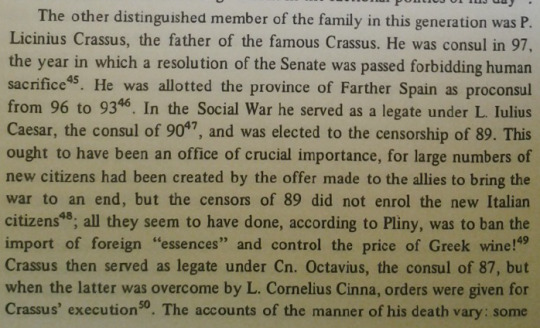
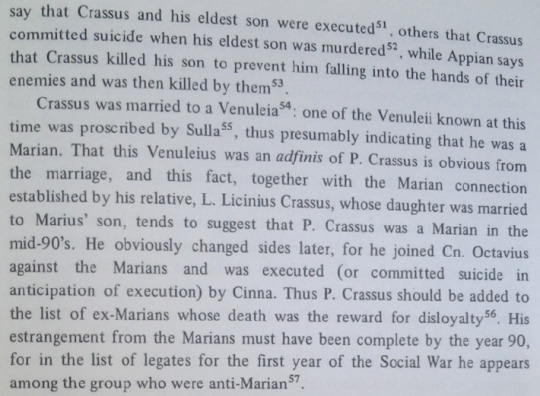
Crassus: A Political Biography, B.A. Marshall
also. currently, if you look Publius Licinius Crassus up on wikipedia for an overview, his page lists his son (and also my main character for this comic) with the cognomen Dives, which is in-fucking-correct.

Marcus Crassus and the Late Roman Republic, Allen Mason Ward
and to circle back to houses and meals shared with family, some citations that made me feel some kind of way when I read them


Marcus Crassus and the Late Roman Republic, Allen Mason Ward
finally, there is discourse or whatever on the placement of the sons of Publius Licinius Crassus. Crassus is the baby brother here simply because I'm writing this story and I get to pick the themes, but also because no one has provided a solid enough argument for him being the second eldest son that I'm willing to buy into with enthusiasm, and I'm more inclined towards G. Sampson's conclusion on the matter.


Defeat of Rome: Crassus, Carrhae, and the Invasion of the East, Gareth C. Sampson
and while I'm just kind of talking about stuff that I read that I enjoyed, this article by Martin Stone lives in my head rent free

A Year of One's Own: Dating the Praetorship of Marcus Crassus, Martin Stone
#trikaranos the komik#hehghghh HELLO i'm back. oof. hgh#if i think too much about them as a family i take critical damage to my hit points
643 notes
·
View notes
Note
not anonymous cause you’ll know it’s me
Bae give me private Jackson ANYTHING
Private Jackson Headcannons
Private Daniel Jackson x reader
AN: During this I laughed, I cried, I went the bathroom, I drank 400mg of caffeine, I probably hallucinated Jackson at some point. It was a whole lotta fun though! I also go back and forth betweeen calling him Jackson, and Daniel. Hope that's ok !! This one's for u princess Diana 🙂↕️.

⋆。˚ ꕥ⋆。˚ ꕥ⋆。˚ ꕥ⋆。˚ ꕥ⋆。˚ ꕥ⋆。˚ ꕥ⋆。˚ ꕥ
I like to think that this boy grew up in a log cabin on bumfuck mountain Tennessee with upwards of seven siblings. Like his parents were under the impression that meant one child to love for each day of the week.
Due to this, Jackson never really had any privacy as he grew up.
So, when he moves in with you after the war, he has a giddy teenage sense of "Oh we can do whatever we want now 😏."
And I mean are you going to turn him down??? No, you aren't bc I've seen this tag!!!
⋆。˚ ꕥ⋆。˚ ꕥ⋆。˚ ꕥ⋆。˚ ꕥ⋆。˚ ꕥ⋆。˚ ꕥ⋆。˚ ꕥ⋆。˚ ꕥ⋆。˚ ꕥ⋆。˚ ꕥ⋆。˚ ꕥ⋆。˚ ꕥ
Anyway... Church on Sunday is a non-negotiable with him. Mainly because he's excited to show you off to all of his friends!! Bonus points if you went to the same church and essentially grew up with him there.
In this scenario, he walks in with you on his arm (saving room for Jesus ofc) and all of the elders are like, "we just knew you too would hitch up one day!" Or "God really did cut y'all from the same cloth!"
It boosts his ego bc he has quite literally dreamed of this day since he was a little boy.
His family would sit a pew behind your family's every Sunday and he'd watch your ponytail swing behind your neck as you sang along to the choir.
He'd started off by daydreaming about the day you two would stand on that same stage and saw your vows. It got him through the boring part of the sermons.
That same dream single handedly brought him home from the war too, you were just too good to be left alone at home, or worse, with someone who didn't love you as much as he did.
⋆。˚ ꕥ⋆。˚ ꕥ⋆。˚ ꕥ⋆。˚ ꕥ⋆。˚ ꕥ⋆。˚ ꕥ⋆。˚ ꕥ⋆。˚ ꕥ⋆。˚ ꕥ⋆。˚ ꕥ⋆。˚ ꕥ⋆。˚ ꕥ
He is very much a "HEY SUG, WATCH THIS" boyfriend.
He would begggg for your attention just so he could show you how he could balance a glass coca cola bottle on a fence and then shoot it to shards with one hand and one eye.
The war robbed him of most of his innocence, but he never lost that child-like glimmer in his eye when he managed to impress you.
(It really wasn't that hard though, you'd hype that boy up for anything, but he didn't have to know that 😉.)
⋆。˚ ꕥ⋆。˚ ꕥ⋆。˚ ꕥ⋆。˚ ꕥ⋆。˚ ꕥ⋆。˚ ꕥ⋆。˚ ꕥ⋆。˚ ꕥ⋆。˚ ꕥ⋆。˚ ꕥ⋆。˚ ꕥ⋆。˚ ꕥ
I believe that after the war, Jackson went to work some insanely blue-collar job. More specifically, I think he either worked as a brick layer or a stone mason.
I also believe that you two live in a small mountain community with only a handful of people and very VERY few neighbors and a longggg winding dirt driveway.
So, when he'd be walking home from a long, hard day's work, he'd have his sweaty work clothes shed by the time he got to your doorstep.
You'd be cooking supper in the kitchen and hear the screen door swing open and would see Daniel in his work boots and underwear walking toward you.
He'd engulf you in a tight hug. His skin still glistening and his short blonde hair sticking to his forehead as he squeezed you into him. He'd plant a big, wet, sloppy kiss to your cheek, and it'd make you giggle. It was as endearing as it was disgusting❤️.
⋆。˚ ꕥ⋆。˚ ꕥ⋆。˚ ꕥ⋆。˚ ꕥ⋆。˚ ꕥ⋆。˚ ꕥ⋆。˚ ꕥ⋆。˚ ꕥ⋆。˚ ꕥ⋆。˚ ꕥ⋆。˚ ꕥ⋆。˚ ꕥ⋆。
As far as dates are concerned, you two only have a few places to choose from, but Daniel always makes sure to make it a memorable experience!
His favorite place to take you is Granny Fish's Catfish kitchen. They give you a fishing pole and a tiny cob of corn. The whole point of the restaurant is that whatever you catch, they'll cook.
So, he stands, fishing pole feet deep in the river, and asking you question after question about your day. Like a puppy whose owner just returned from a day trip, he listens intently to your answers.
Honestly, he's just happy God let him live to hear your voice.
He is such a southern gentleman, just like those guys in gone with the wind!!
He'll push out your chair out for you, and you'll watch his blushy pink lips curl into a sweet smile.
He'll even reach his arm across the table and intertwine your fingers.
Looking into those ocean blue eyes, completely love drunk on you is not something you should take lightly. That man loves you DOWN.
⋆。˚ ꕥ⋆。˚ ꕥ⋆。˚ ꕥ⋆。˚ ꕥ⋆。˚ ꕥ⋆。˚ ꕥ⋆。˚ ꕥ⋆。˚ ꕥ⋆。˚ ꕥ⋆。˚ ꕥ⋆。˚ ꕥ⋆。˚ ꕥ⋆。
Love this man
Absolutely no hate to this man
But he is an absolute HICK.
Like there is no other way to put it. The country bumpkin is so key to his being that sometimes his mannerisms are just the tiniest bit inexcusable.
FOR EXAMPLE
One afternoon, you were inside painting a portrait of you two to hang above the couch in your living room, and you felt a swoosh of wind pass you.
You looked into the hallway and saw Jackson walk past your room with a bottle of "Mane and Tail Horse Shampoo."
"Hey baby?" You called out. "Where are you heading with that??"
He back tracked to the room you were in only to quip a short, "bath," and head back over to the screen door.
With your face scrunched in confusion, you paced toward the window to follow the man with your eyes.
You watched as Jackson slipped into his birthday suit and jumped in the river that ran through your back yard. Once he got himself all wet, he squirted a dollop of the shampoo in his hair.
You were watching the absolute love of your life, a decorated war veteran, bathe himself. In a river. With horse shampoo.
Congrats girl! This is your life.
⋆。˚ ꕥ⋆。˚ ꕥ⋆。˚ ꕥ⋆。˚ ꕥ⋆。˚ ꕥ⋆。˚ ꕥ⋆。˚ ꕥ⋆。˚ ꕥ⋆。˚ ꕥ⋆。˚ ꕥ⋆。˚ ꕥ⋆。˚ ꕥ⋆。
Yall I hate to have to do this but it must be said.
Jackson may be living his dream life with you, but the war still very much haunts him.
He's gotten pretty good at managing his pain throughout the day. Whether that be by thrusting himself into his work, or spending quality time with you, it doesn't dominate his life anymore.
But those nights, those nights where even though your in bed beside him, he's truly alone in his head.
You could sing him lullabies and wake him up with a breakfast in bed fit for a king, but when he's unconscious, it's just him and his memories.
You'd be awaken from your sleep to find a whimpering Jackson with wet under eyes.
He'd be reciting under his breath the prayers that he'd prayed on the battlefield.
Begging Jesus to save the souls of his fallen brothers. Even if they didn't believe in him, he'd ask Jesus to make a little extra room in Heaven for a good man who deserved it.
"Please.." He'd cry. "I know he wasn't baptized, but please God make a little space for em'." He was pitiful.
You'd carefully roll over to bring your arms around him in a soft embrace. You'd also bring the palm of your hand to delicately lay against his bicep to gage the decline of his once racing heart.
Rubbing small circles against his back with the other hand, you coo calming whispers into the shell of his ear.
You'd repeat this cycle as many times as you needed to if it meant he'd finally get a good night's sleep.
Usually, Jackson would awake to stare at you with big, sleepy eyes. He'd press a kiss to your lips and hug into you as you both lulled back to sleep.
⋆。˚ ꕥ⋆。˚ ꕥ⋆。˚ ꕥ⋆。˚ ꕥ⋆。˚ ꕥ⋆。˚ ꕥ⋆。˚ ꕥ⋆。˚ ꕥ⋆。˚ ꕥ⋆。˚ ꕥ⋆。˚ ꕥ⋆。˚ ꕥ
His time in Europe is not something he actively seeks to talk about. So, you don't normally get to take the armchair therapist route with him. You let him know you'll always be there for him in other ways like leaving a loving note in his lunch box you'd have gotten up early to pack, or making sure the medals he'd earned never gathered even a speck of dust.
Of course, he knows this. He'd also let you know he's thankful for your support by working his hind tail off to give you a life you'd be honored to call yours.
⋆。˚ ꕥ⋆。˚ ꕥ⋆。˚ ꕥ⋆。˚ ꕥ⋆。˚ ꕥ⋆。˚ ꕥ⋆。˚ ꕥ⋆。˚ ꕥ⋆。˚ ꕥ⋆。˚ ꕥ⋆。˚ ꕥ⋆。˚ ꕥ
He's a poor country poor who got dealt a bad hand in a lot of different parts of his life, but he thinks himself rich because of the life the two of you have built together.
It's pretty safe to say that he loves you in a way that could only be rivaled by that of Orpheus and Eurydice, except if you asked him, he'd never screw up his life with you the way Orpheus did.
Anything there is to face, you'd face it together.
⋆。˚ ꕥ⋆。˚ ꕥ⋆。˚ ꕥ⋆。˚ ꕥ⋆。˚ ꕥ⋆。˚ ꕥ⋆。˚ ꕥ⋆。˚ ꕥ⋆。˚ ꕥ⋆。˚ ꕥ⋆。˚ ꕥ⋆。˚ ꕥ
#saving private ryan#saving private ryan headcannons#saving private ryan x reader#spr x reader#Private Jackson x Reader#Jackson x Reader#Private Jackson#Private Daniel Jackson#Hes so country#love him#cutie#i hope diana likes this
23 notes
·
View notes
Text

Saint Thomas the Apostle
1st century
Feast Day: July 3
Patronage: architects, builders, construction workers, stone masons, against doubt, against blindness, East Indies, India
One of the original 12 apostles, St. Thomas was ready to die with Jesus in Jerusalem but is best remembered for doubting the Resurrection until allowed to touch Christ's wounds. He preached in Parthia, Persia, and India. He formed many parishes and built many churches over a wide area and was eventually martyred for his faith.
Prints, plaques & holy cards available for purchase here: (website)
#StThomastheApostle#Saintquote#catholicartist#catholicillustrator#saintart#catholicsaints#patronsaint#patronsaints
68 notes
·
View notes
Text

THE 7-RUNGED LADDER OF THE MYSTERIES
A symbol of progressive advancement from a lower to a higher sphere, which is common to Freemasonry and to many, if not all, of the Ancient Mysteries. In each, generally, as in Freemasonry, the number of steps was seven.
LADDER, BRAHMANICAL
The symbolic ladder used in the Mysteries of Brahma has seven steps, symbolic of the seven worlds of the Indian universe. The lowest is the Earth; the second, the World of Coexistence; the third, Heaven; the fourth, the Middle World, or intermediate region between the lower and the upper worlds; the fifth, the World of Births, in which souls are born again; the sixth, the Mansion of the Blessed; and the seventh, or topmost round, the Sphere of Truth, the abode of Brahma, who is himself a symbol of the sun.
LADDER, QABALISTIC
The ladder of the Qabalists consists of the ten Sephirot, or Emanations, of Deity. The steps are in an ascending series: Kingdom, Foundation, Splendor, Firmness, Beauty, Justice, Mercy, Intelligence, Wisdom, and the Crown. This ladder forms the exception to the usual number of seven steps or rounds;
LADDER, MITHRAITIC
In the Persian Mysteries of Mithras, there is a ladder of seven rounds, the passage through them being symbolical of the soul's approach to perfection. These rounds are called gates, and in allusion to them, the candidate is made to pass through seven dark and winding caverns, which process is called the ascent of the ladder of perfection. Each of these caverns is representative of a world, or a state of existence, through which the soul must pass in its progress from the first world to the last, the World of Truth. The seven steps are further symbolized by the seven planets and the seven metals. Thus, beginning at the bottom, we have Saturn represented by lead, Venus by copper, Jupiter by tin, Mercury by qiucksilver, Mars by iron, the Moon by silver, and the Sun by gold; the whole being a symbol of the sidereal progress of the sun through the universe.
LADDER OF IZADOSH
This ladder, belonging to the advanced Degrees of Freemasonry, consists of the seven following steps, beginning at the bottom: Justice, Equity, Kindliness, Good Faith, Labor, Patience, and Intelligence or Wisdom. Its supports are love of God and love of our neighbor, and their totality constitute a symbolism of the devoir or duty of Knighthood and Freemasonry, the fulfillment of which is necessary to make a Perfect Knight and Perfect Freemason.
LADDER, ROSICRUCIAN
Among the symbols of the Rosicrucians is a ladder of seven steps standing on a globe of the earth, with an open Bible, Square and Compass resting on top. Between each of the steps is one of the following letters, beginning from the bottom: I. N. R. I. F. S. C., being the initials of Iesus, Nazarenus, Rex, Iudaeorum, Fides, Spes, Caritas. These words suggesting Jesus of Nazareth, King of the Jews, Faith, Hope, Charity. But a more recondite or hidden meaning is sometimes given to the first four letters (INRI - All of Nature is Renewed by Fire).
LADDER, SCANDINAVIAN
Doctor Oliver refers the symbolic ladder used in the Gothic Mysteries to the Yggrasil, or sacred ashtree. It retains the idea of an ascent from a lower to a higher sphere, which was common to all the mystical ladder systems. At its root lies the dragon of death; at its top are the eagle and hawk, the symbols of life.
LADDER, THEOLOGICAL
The symbolic ladder of the Masonic Mysteries refers to the ladder seen by Jacob in his vision, and consists, like all symbolical ladders, of seven rounds, alluding to the four cardinal and the three theological virtues: Temperance, Fortitude, Prudence, Justice, Faith, Hope, and Charity
LADDER, JACOB'S
While sleeping one night on the bare earth and a stone for his pillow, Jacob beheld the vision of a ladder, whose foot rested on the earth and whose top reached to heaven. Angels were continually ascending and descending upon it, and promised him the blessing of a numerous and happy posterity. This ladder, so remarkable in the history of the Jewish people, finds its analogue in all the ancient initiations. It is certain that the ladder as a symbol of moral and intellectual progress existed almost universally in antiquity, presenting itself either as a succession of steps, of gates, of Degrees, or in some other modified form. The number of the steps varied; although the favorite one appears to have been seven, in reference, apparently, to the mystical character almost everywhere given to that number. - An Encyclopedia of Freemasonary and its Kindred Sciences by Albert C. Mackey MD
67 notes
·
View notes
Text
Magnum Opus or Great Work: Alchemical Codes in "Harry Potter"
"I've never wanted to be a witch, but an alchemist, now that's a different matter. To invent this wizard world, I've learned a ridiculous amount about alchemy." JKR. By the way, it seems JKR never became an alchemist because you can't be that evil an alchemist, Joanne. Something went wrong.
The first part about Lily and James
Voldemort – an occult alchemist, Lucifer. Snape – a Seeker who chose the wrong Path. Dumbledore – Keeper of the Tower. Hermione – Hermes Trismegistus. Harry, Hermione and Ron – the three principles for creating the Philosopher's Stone.
Alchemy is the universal path of spiritual transformation. In a literal sense, universal, this code is practically everywhere–from ancient myths and the Bible to the philosophy of Nietzsche (though in his understanding) and Jung's books. Harry Potter himself is a complete alchemist's path, but there's also a well-displayed second path–the path of the occult alchemist.
True alchemy tells us that God is in everything, like a seed present in every person. Through alchemical transformation, a person can be reborn – and become golden, divine, immortal.
Many famous people were fascinated by these ideas – from Newton to Goethe, from Walter to Mozart. Yes, Walter and Mozart were freemasons, but freemasonry is built on the Magnum Opus, it's its foundation. Who has seen the opera The Magic Flute? A completely masonic opera: the surface layer was for the people, and the deeper layer – for the spiritual elite of that time. In this opera, the power of love transforms people and makes them divine. Oh, it seems to resemble Harry Potter, hehe... Harry Potter also has two layers – one as a fairytale about a wizard for teenagers, the other – for those who can "feel" the symbols, even without knowing them.
Each symbol can be interpreted in several ways, that's the complexity of alchemical symbolism. For example, Albus Dumbledore. He symbolizes (in JKR's own words) Spirit ( he's white), and Rubeus Hagrid – Soul (red) – and they're both like two fatherly figures for Harry, distant and warm, judicious and understanding. But all this is at the character level. Dumbledore has other meanings – much more important ones. As I've said before, the symbolic level and the character level are different levels. In interpreting symbols, you don't need to interpret every line, you need to take the context as a whole. Characters operate on one level, symbols – on another.
So, alchemy is an extension of the universal idea – to be reborn, you need to "die." Like Jesus died on the cross, Orpheus on the banks of the River Gebre, and Osiris in the coffin prepared by Typhon, in alchemy, until all the elements (parts of the old personality) die, the work cannot be completed.
The stages of this alchemical process can be traced in the lives of almost all world "heroes" and in the mythology and legends of many cultures. This is a universal code.
“Very truly I tell you, no one can see the kingdom of God unless they are born again” John 3:3
Alchemy proclaims that without decomposition, the Great Work cannot be accomplished.
The past Self dies on the cross and in the retorts and becomes black during decomposition. The new Self rises from hell, like a phoenix. The phoenix is a pure alchemical symbol.
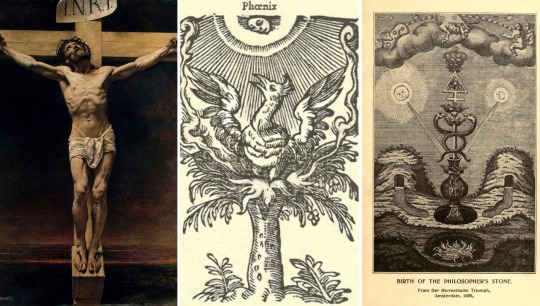
This is the creation of the Philosopher's Stone.
It is symbolically described in "The Chymical Wedding of Christian Rosenkreutz". The book presents an allegorical story divided into "Seven Days" or "Seven Journeys," which tells how its author, Christian Rosenkreutz, was invited to a castle full of wonders to help with the "Chymical Wedding" of the king and queen. Harry also receives a letter in a storm (like Rosenkreutz) and goes to the castle for 7 years, chooses one of the four paths (Gryffindor), and so on.
Alchemists called the creation of the Philosopher's Stone the Great Work – Opus Magnum. This process consisted of three stages: decomposition (nigredo), rebirth (albedo), and final perfection (rubedo). Each of these stages corresponded to a specific colour: black, white and red.
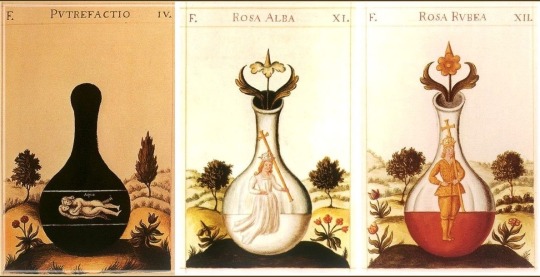
Nigredo. Albedo. Rubedo.
In Harry Potter, these stages correspond to Sirius Black, Albus (white) Dumbledore, and Rubeus (red) Hagrid. The end of each stage is marked by their death. In the seventh book, it's Hagrid who carries the "dead" Harry.
There is a fundamental difference between "true alchemists" and "occult alchemist."
Tom Riddle is an occult alchemist. For him, the Great Work is also self-creation, but what kind? For him, it is complete mastery of his abilities and his future, and especially the complete liberation of his will.
Tom is a will, but his will not submissive to the will of God. It's a Luciferian will. The will of a fallen angel who began to oppose his own free will to the influence of Divine Love-Light. Instead, he sought and loved his own power outside Divinity, in himself.
"Better to reign in Hell, than serve in Heaven" John Milton, "Paradise Lost"
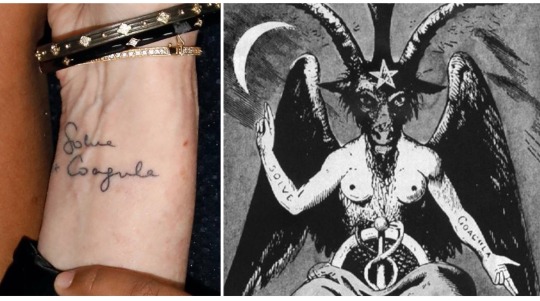
Baphomet, or the Sabbatic Goat, drawing by Eliphas Levi, on its hands are inscriptions "Solve et Coagula." This is an alchemical principle. JKR, by the way, also has such a tattoo.
In occultism, it is believed that magic is control of one's will, and a will can control matter. After all, what did his followers choose for their motto? Magic is Might. Harry never defeated Voldemort with such magic. Because he doesn't need it.
What does Tom boast about? Tom boasts that he has mastered the deepest depths of dark magic. He went so far in it as no one before. Dark magic requires an iron will, and Tom achieved incredible heights in it. He even achieved immortality in this material universe, literally cursing his soul! Only Tom doesn't understand that Dumbledore (a true alchemist) is not interested in all this. Because true immortality is not there. True transformation is not there. Because their paths are completely different – Dumbledore is going to the "God and divine immortality," and Tom is going to "material immortality."
In general, fans of occult alchemy, the Left-Hand Path, and Nietzschean philosophy probably consider Tom a much more interesting character because here he is – the king of matter, a man of incredible will and strength who destroys the slave Christian morality and proclaims that God is dead, long live the Übermensch (homo superior)! (Nietzsche would have been proud of him…) By the way, Bellatrix is most likely symbolically – Lilith, Adam's first wife according to Kabbalistic apocrypha, who rebelled against Adam. God created them equal, and Adam wanted to have power over Lilith... In short, Lilith is the first feminist in human history, hehe.
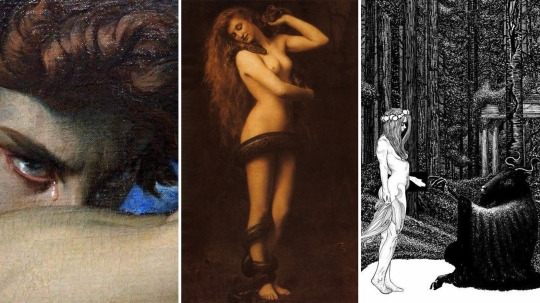
The Fallen Angel by Alexandre Cabanel. Lilith.
In short, Tom Riddle is such an adept of broken alchemy. Where Tom is his own personal will, Harry is Faith and the will of the Spirit. Harry is also very strong-willed, but his will is different, it's not individualistic. It's a will of sacrifice, a will of love, a will of mercy, a will of trust. The main theme of the seventh book is a crisis of faith. And what kind of will does one need to show to continue the quest for Horcruxes and not go for the Deathly Hallows? Simply put, the will of Harry and Tom is completely different.
And Tom will never understand this. He's an individualist. He's a Nietzschean Übermensch. He's reached the limits of human capabilities. But for what? From dust you are and to dust you shall return, Tom...
Severus Snape — a Seaker who chose the wrong Path
And Snape, by the way, initially turns away from Lily (Lily is love of God, represented in the world). Because he's obsessed with becoming dark magic, his ego and desire for secret knowledge and being proud are very great.
Btw, Lily is a mudblood. In the sense that God is not in shining beautiful armor. This is Lucifer's mask – to be pure, to shine, to sparkle. But the real God can be found by seeking, under the feet of the poorest and "dirtiest" person. After all, for God, everyone is equal. It's the Devil who divides.
And pure-bloods, for example, the Blacks, are "false purity." Luciferian purity. Material purity, purity of shining gold. It's division. And where there's division – there's the Devil.
In short, Snape turns away from Lily because this path is difficult, he doesn't understand how to approach her, he already uses dark magic, has a lot of knowledge, and delves into various secrets, and shows what "bad" paths other seekers (the Marauders) take... (The seeker is not my term, it's from the Rosicrucian manifesto, alchemists call themselves seekers) But Lily still refuses to unite Spirit and Soul. And he calls her a "mudblood," insulting her. For Lily, this is a sign that this soul is almost lost. And there's no sincere regret in him when he asks for forgiveness. He asks her to forgive him, but his soul is still on the old Path. Lily isn't angry with him, it's not about anger or offense. Snape's soul is almost lost at this moment, closed to the divine spark and love. After all, for love to enter your heart, you first need to open yourself to it.
Only when Snape sees true face of Tom's "alchemy," in which Tom is ready to kill Love, the divine spark, essentially kill God in the souls of all people, then Snape, as a real Seeker, realizes that he's going the wrong way... And he runs to the main Alchemist, Dumbledore, to ask to preserve this love, this manifestation of God on earth.
But you can't preserve it without preserving the seeker of the right Path in your soul (James) and without preserving the possibility of the emergence of the transformed soul (Harry).
This is a very important moment, not only because you can't kill people in principle. Dumbledore literally tells him that you can't save love of God, the divine spark in your soul, if you kill in yourself the one who reaches out to God (the deer) and if you kill the POSSIBILITY of becoming this new transformed soul (Harry).
For Snape, this becomes a turning point, and he decides to switch sides to true alchemy. Dumbledore asks in return for Snape's soul, but not in the sense that the Devil demands it, he asks for loyalty to the Path. Below I'll explain the symbolism of Dumbledore and what he means in terms of alchemical symbolism (I don’t think he is God).
Snape becomes loyal to Dumbledore. But Lily is killed, as is James. The world, despite the fact that Voldemort temporarily goes into hibernation (and the Savior is alive), plunges into despair. Sirius (as a divine symbol of light) is in captivity, Remus (a symbol of a seeker with a "good but not brave" soul) is somewhere wandering the world, and Harry lives very poorly with the Dursleys... Harry doesn't know any God, and the seeker in him is also "dead". And Voldemort will soon rise again, he's just gathering strength.
Harry's path is the path of returning to God through Mother of God (Theotokos). Because it is Mother of God who is the true Spirit. That's why he meets Lily only at the end of the seventh book, when he's almost completed the alchemical transformation. For Christians, this is heresy, but for alchemists, it's not. The Son and Mother of God are one whole. The Virgin Mary is part of the Trinity, because only through the spiritual unity of the Mother and the Son is the salvation of humanity possible.
And who does he meet her through? Through Snape. Who dedicated his entire life to transforming his Soul, merging it with the Spirit, ultimately coming to God.
He spent his whole life hating James, as a Seeker of a different kind, not like him—Snape always leaned a bit towards Nietzschean stories. And James always hated Dark Magic and all dark things (although this doesn't make the souls of this type much better, they can also be egocentric). Snape teaches Potions, he knows how to bottle up Love, Death and Luck... So much power, so much pride in this...
Recently, I reposted a very interesting post. Snape wanted to recover his soul, because he was guilty of Lily's death. A very beautiful meta, but I see a bit different alchemical meaning. His soul is broken not only because Lily partly died because of him. His soul is broken overall because of the Path he chose - that of an occult alchemist, and he remains a "spy" to the end of his days, playing two roles, constantly "here and there". He dies at the hands of his former master.
Snape takes Lily's letter because he needs Lily's love (like people wear crosses), while there isn't enough understanding of where to go (Dumbledore is already dead)
Snape always yearned for Lily. And Dumbledore asks for us, the readers: "After all this time?" And Snape answers for us "Always." You must love God always. And that is salvation for the soul.
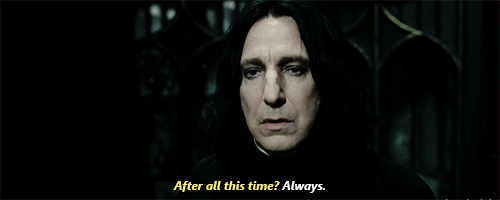
In general, Snape only understands towards the end that you cannot love Lily without Harry and even James. Only one Path leads to Lily - the same as James’s path. The path of Ego, pride, thirst for power, secret knowledge, occultism, malice, hatred must finally dissolve. Snape fully exposes himself to Harry, although he shouldn't have (he should only pass on information about death), revealing the good (and the bad) that he always hid. His revelation to him speaks of his complete acceptance. He shows him his soul, literally bowing his head to him - here I am, here is my soul, in some things I have no excuse, sometimes I have justification, but I've been seeking God, seeking love all my life.
Will you accept my wounded soul?
This is confession. The realest confession.
And Harry accepts. Of course, Harry accepts. He looks at him with Lily's eyes.
Because no matter how "bad" you are, if you truly love God in your soul, if you truly seek Him, there will always be a place for you in the City of God. Snape is the constantly replayed plot of the Prodigal Son's return.
At this moment, all the "black" in Snape dies – the nigredo. Tears - the white stage, purification – the albedo stage, purification. Blood – naturally, the red stage. The alchemical transformation for Snape is complete.
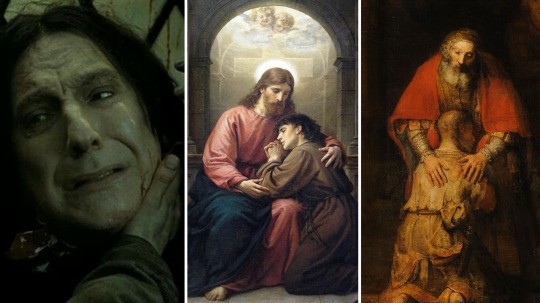
(But geniuses from TikTok will still say that Harry shouldn't have named his son Albus Severus, because Snape was baaaad. Ofc he was bad sometimes, that's the point!)
Dumbledore is the embodied Path and Plan
As I mentioned before, Dumbledore asks for Snape's soul in return, but not in the sense that the Devil demands it, he asks for loyalty to the alchemical Path.
Dumbledore, as an alchemist, besides embodying the completion of the albedo stage for Harry with his death, is also the embodied Path. Dumbledore is the highest Guardian of the Tower, who watches over the Paths of others, he is the Man of Spirit, he is the Principle, he is the Master. What is the difference between Dumbledore and Lily? Lily is a more important symbol, she is like pure divine power, God = love, as in what all souls dissolve. Dumbledore, on the other hand, is the Guardian of the Path through which everyone must pass. In short, Lily is the answer to the question "where", and Dumbledore is the "how". And Dumbledore is just a man who also underwent his alchemical transformation and who can also succumb to temptation. But Dumbledore is not GOD, imo. To personify God in a book is too much (even for me, although I’m not religious at all). I don’t like the idea of him being God and... really, where? God is transcendent and pure divine love emanates from Lily that’s why she almost an empty canvas. Dumbledore is a principle. He is the answer to the question "HOW". That's why he asks to believe in him, believe in the ALCHEMICAL PATH AND PLAN. FOLLOW THIS PLAN TO THE END. Ascend the tower, as I once ascended it. After all, he lives up there in the tower. He observes.
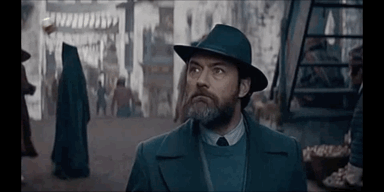
For Snape, Dumbledore is so important because Dumbledore is the Path, a new Path that he did not have. And Dumbledore's death is so important for everyone because now no one points them towards the Path. But they must find this Path within themselves. Because the answers are inside them. You cannot become a true Alchemist if you constantly rely on external help. It's time to see the Path independently.
"You must kill me."
There was a long silence, broken only by an odd clicking noise. Fawkes the phoenix was gnawing a bit of cuttlebone. (HP and DH)
After Dumbledore says that Snape must kill him, there is silence and a very clear symbol - the phoenix and the bone. It's time for their souls to go independently, to eat away all the old to come to rebirth. Meanwhile, they also need to save Draco, who, by "Lucifer's" order, is about to kill the Path (although you can't outplay God's plan...). And then Dumbledore reveals that Harry must die.
This shocks Snape. Like any alchemist on the Path. How so, to die? After all, we all do everything to become closer to God, to immortality, and you say – just die? What kind of Path is this?
"I thought…all these years…that we were protecting him for her. For Lily.”
After all, we were protecting Harry for Lily, because as I've already said, only through the spiritual unity of the Mother and the Son is the salvation of humanity possible. Snape is protecting the son for the mother, and Dumbledore wants to kill him? For what?
Simply put, Snape doesn't understand that no one can save Harry until he dies and is reborn. It's painful, but all heroes go through this path for rebirth.
Dumbledore knows that there is a "seed" of "evil" in Harry, as in any of us. After the fall, we all carry Luciferian part within us. This is the last thing that must die in Harry, and he himself must die for it.
No one promised that the path of the alchemist would be easy. It's understandable why not everyone loves Dumbledore, he seems too cold and manipulative, but there is no other way for Harry on the symbolic level.
The Great Work
There are three stages of the Great Work: decomposition (nigredo), purification (albedo) and ultimate perfection (rubedo). These stages for Harry culminate in the deaths of Sirius Black, Albus Dumbledore, and his own death, where he is carried out of the forest by Rubeus Hagrid.
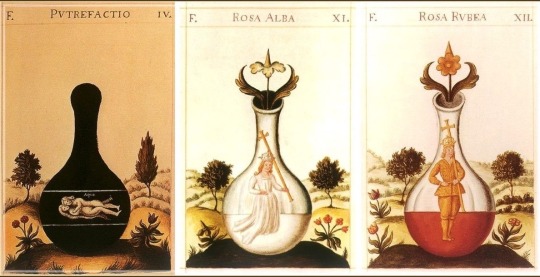
And the result of his alchemical work should be Rebis — essentially the alchemical philosopher's stone, an androgynous being. In the collection of dialogues attributed to Hermes Trismegistus, God is depicted as androgynous. (Hermes Trismegistus is essentially the one who created the corpus of Hermetic texts).
Rebis is the unity of opposites. Day and night, Man and Woman, Good and Evil, Light and Darkness. All is one. There is no division. The wholeness of God. After the fall, we are all divided. And after the alchemical transformation, we can finally become whole and find ourselves and God.
In the form of merged men and women, sometimes depicted as the Virgin Mary and Christ, because They are one whole. As I have already said, for many alchemists, the Virgin Mary is part of the Trinity because only through the spiritual unity of the Mother and the Son was the redemption of original sin made possible. As I have already said, although Harry suffers more for James (his father turned out not to be as ideal as he thought), Lily is the main symbol in "Harry Potter".

The Nigredo stage literally means "blackness" - it signifies complete breakdown, decay, descent into the underworld, the trance of grief. It's a descent into the deepest fears, disbelief, denial, loss of self, anger, aggression. And through this - a return to the prima materia. This is what happens to Harry, "The Order of the Phoenix" is a very dark and depressing book, and with Sirius's death, this stage for Harry is completed. Sirius himself also undergoes transformations, but about this in the next part. The nigredo stage, during which a person's ego dissolves, is agonizing but necessary for further development. After the "I" meets its "shadow" and disintegrates into parts, it will need to be purified and recreated.
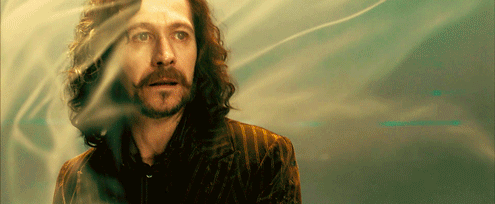
Albedo ("whiteness") symbolizes purification, transition to another world, change of life priorities, awakening, enlightenment. In alchemy, the transition from nigredo to albedo is achieved through the process of washing. The whole sixth book is misty, "white", "wet". "Washing" (albutio, baptisma) directly leads to whiteness (albedo). Purification. It's also silver, a lunar state. In Harry Potter, there is a character named Luna, which means moon in Latin. In different parts of the books, Luna also symbolizes this stage. With Dumbledore's death this stage for Harry completed.
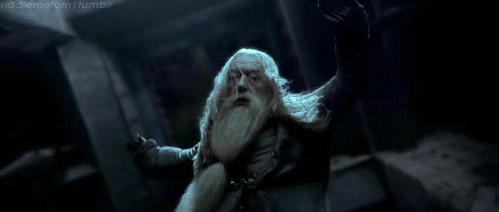
Rubedo ("redness") - the final stage of the alchemical Great Work. The alchemist must establish a kind of sacrificial relationship with his inner essence. At the final stage, the so-called "alchemical marriage" takes place: the marriage of the Red King and the White Queen - Soul and Spirit. Harry (soul) and Lily (spirit) are united. With Hagrid carrying Harry this stage for Harry completed.

Bu the way, the Golden Snitch is an alchemical symbol also.
Firstly, Harry's position is called the Seeker. Alchemists also called themselves that. Secondly, the winged disc is a very ancient symbol, meaning the sun (God) and immortality.
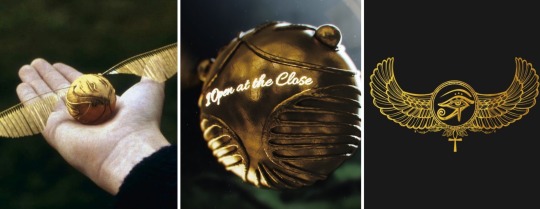
The Snitch reveals to him the Resurrection Stone, and Harry "encounters" his main symbols, but the main one is Lily. It is her he asks not to leave him.
Harry's death here is read by everyone as the well-known plot of Christ's crucifixion. The path to this death is also a reference to the agony of Jesus in the Garden of Gethsemane before the Crucifixion. After all, Harry also wanted to end up somewhere, but Hogwarts is his home, and he accepts his fate.
My Father! all things are possible for Thee: take this cup of suffering away from me: and yet not what I desire, but what Thou desirest. Mark 14:36
He wanted to be stopped, to be dragged back, to be sent back home... But he was home.

Lily's Eyes
To be honest, I can assume that her green eyes was chosen at random. But what if they weren't? Her green eyes may seem illogical, as this is the colour of the snake, the colour of Slytherin, the colour of evil. But this is the occult Luciferian snake, the erroneous snake. Originally, green also dates back to Hermes Trismegistus – the god who gave the knowledge of alchemy. The most famous of the old hermetic-alchemical texts is inscribed on the "Emerald Tablet". According to legend, this document was left by Hermes Trismegistus on a plate of emerald in an Egyptian temple.
"The Emerald Tablet" is very important for alchemists." According to legend, a large emerald fell to the earth from Lucifer's head when he was cast out of heaven. From the same emerald that fell from the crown of the fallen Lucifer, angels made the Holy Grail (which is also the philosopher's stone, and the Snitch...). Emerald is a sacred green stone, and the heavenly divine world - the homeland of the emerald - a precious stone in which information about the heavenly homeland is encoded.
There is also the Ouroboros - a snake that devours its own tail - a symbol of infinity and immortality.
And the Snitch, which is a reflection of Hermes Trismegistus' staff (which has two battling snakes - two opposites, Spirit and Soul, Good and Evil and so on, and Hermes establishes unity between them with his staff).
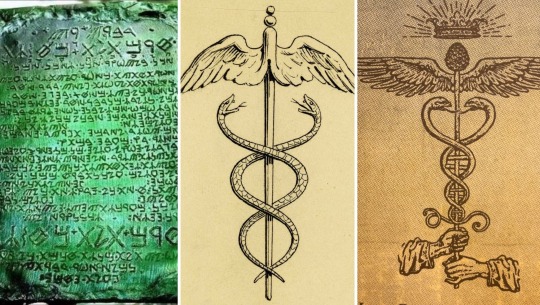
Occultists, of course, interpret these symbols in their own way.
Hermione is Hermes Trismegistus. Mercury. Ron — Sulphur. Harry— Salt.
Hermione (Ἑρμιόνη [hermi. ónɛː]) is a feminine given name derived from the Greek messenger god Hermes. As I said, Hermes Trismegistus is the main figure of Hermetic teaching, he is also the one who predicted the coming of the Savior (traditional Christianity should not be confused with Gnostic teachings, the Church has always been against Gnosticism). In addition, Hermes is Mercury, and that is knowledge. Hermes Trismegistus shares "secret knowledge" with the world, which forms the basis of many Gnostic directions - from alchemy to Kabbalah.
Hermione is a little alchemist, she shares knowledge. It is Hermione who insists on complete trust in Dumbledore, it is Hermione who often leads Harry in the right direction when Dumbledore is not around. It is through Dumbledore and Hermione that "moral lessons" are often sounded, which often seem completely out of place. Like when Dumbledore says that James would forgive Peter. At that moment, I always want to say, "Are you out of your mind?!" although I understand that it is described on a symbolic, not personal level.

Mercury (Hermione), Sulphur (Ron), and Salt (Harry) were necessary in the alchemical transformation and were the main components. To create the philosopher's stone, all three elements had to be combined, and Harry is next to them throughout all the books.
Both Hermione and Ron are equally important in Harry's development.

Mercury is the more fluid primary principle, more rational, the feminine principle, while Sulphur is dynamic, expansive, unstable, acidic, unifying, masculine, paternal, and fiery principle. Sulphur is emotional, it is desire and passionate impulse that motivates life. Sulphur is desire. And according to Jung's reflections, it can also be foul and dangerous. Complete transmutation depends on the correct application of this variable principle. Sulphur must be of quality for transmutation to occur. And Ron achieves this quality.
Also, in mystical alchemy, Sulphur is crystallized inspiration of Mercury (Mercury).
Mercury and Sulphur are simultaneously antagonists, like the male and female elements, but at the same time Sulphur is crystallized Mercury.
So I have always been and will always be for Romione! Hehe. They were made for each other!
And as for Salt - that's Harry. It's the body. Sometimes it is called earth and body, salt is the essential body (corpus).
Alchemists say that salt was the first substance created by fire, emanating from God. In salt, all creation is concentrated, in salt the beginning and the end of all things.
Salt is associated with the ultimate elevation of matter - with matter that has acquired consciousness, achieved through the unity of opposites, including the unity of fire and water, the unity of what is above and what is below. Salt is the ultimate Philosopher's Stone, representing transcendence and ultimate knowledge.
Thus, salt symbolizes consciousness (thoughts, feelings, material, etc.), which must be elevated through alchemical processes of dissolution and recrystallization. Well, that's Harry himself.
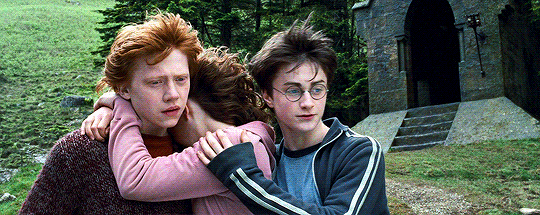
Just love this stupid moment
Well, that's it, I think I've said everything, and from the next part, we can move on to the Marauders themselves :D
#i'm wondering if anyone but me is even interested in this at all#harry potter meta#harry potter#hermione granger#ron weasley#pro ron weasley#rubeus hagrid#pro severus snape#pro albus dumbledore#pro romione#hp meta#severus snape meta#lily evans#tom riddle#voldemort#tom riddle meta#bellatrix lestrange
86 notes
·
View notes
Note
Woods had been preparing a little surprise nearly months in advance, something he carefully spent time acquiring, going through documents after documents of paperwork to even get ahold of it. Yet, he found that as soon as he walked up from the basement (something he still wasn’t used to, and probably shouldn’t get used to, considering he only had around 17 more hours of this left), and heard someone, a cough, someone clearing their throat, he bolted.
It could’ve been an enemy, he could’ve easily gotten himself killed by rushing out without checking, but as soon as he saw Mason, alive, breathing, every thought left his head. He rushed over, shoving a table out of his way, dropping down to his knees in front of his lover (and being pleasantly surprised by the lack of pain from his knees), he began checking for injuries, rough hands lifting his shirt up and patting, watching for flinches, looking for any bruises, cuts, god forbid bullet wounds.
He didn’t realize he was crying until he couldn’t breathe. Hot, choking sobs wracked him, flooding his senses in a way that made him more delirious than he’d ever been in Vietnam. His arms wrapped around Mason’s body, holding as tightly as he could, completely disregarding Bell, as he lay wherever surely somewhere in earshot, or their other Bell, whoever they were lurking. The Valentine’s gift had been forgotten temporarily.
“Mason—I thought—“
Every word was a gasp for air, his lungs burning. Only a few hours ago, Mason had been bleeding out in the middle of fucking nowhere, and Woods hadn’t been able to do a thing. He’d gone and saved Bell, the kid being tortured by Rook, and Woods hadn’t been able to do anything. Even their other Bell had taken a bullet, protected Mason, and Woods had done nothing. He’d thank them later.
All he could do was cry, the Valentine’s gift, a messily thrown together bouquet of handpicked flowers from around the house, a few Polaroids of Woods, Weaver, Hudson and him, some of David, a keychain around one of the flowers, all wrapped together by a recognizable red cloth that a certain Russian Mason had known used to wear, had been dropped to the floor.
- @ask-woods
his chest spotted with reddening squares of thick cotton, wrapped in gauze, riddled with scars and healed and unhealed damage. sheer ghosts of rust ribbons running down his torso. m████ was wounded in action - but he was still alive.
[cutting for length purposes]
he startled at woods sudden appearance, damn near reaching for a gun until he recognized the wet face in front of him. as shock dissipated, he looked over the scene: a table knocked over; woods, sobbing at his feet and tenderly looking over his battered body; a smattering of flowers, polaroids and lovingly curated gifts.
never did he see woods cry so hard. even as a young boy he was as hard as stone, only breaking after hard blows. he could only imagine just how worn down the man was. after everything; the loss of war, the irreparable damage of death, the scarring of betrayal; woods had earned his tears and more. m████ took woods' face in his hands, gentle and soft, and thumbed a cheek dry. "i'm here, woods." m████ coaxed woods up and into his arms. pressing mindless, apologetic kisses to woods' cheek, he too was crying. "i'm home."
m████ breathed woods in, taking in the notes of whiskey, forests, and pennsylvanian rain forever embedded in his skin, melting into his warmth. woods was a fiery soul, emblazoned by his free spirit; radiant and sublime, always to rise from dead, live on and inspire. he was as beloved as the sun of spring.
despite his cruelty to him and betrayal, m████ was always welcomed back, loved, and forgiven by woods. like judas was by jesus. he was only spared of iscariot's fate by denying pantheon their chance to condemn woods, all for a kiss. and a kiss he'll steal.
pulling back, he took a moment to link eyes with woods - he looked like hammered shit. m████ couldn't help but laugh a bit before pulling him into a kiss proper.
6 notes
·
View notes
Text







BATH ABBEY; A GREAT MEDIEVAL CHURCH
1/ The Great East Window
In Bath Abbey, the Great East Window portrays 56 scenes in the life of Christ. This masterpiece was completely restored after it suffered damage during World War II. The windows, made by Clayton & Bell, portray very graphically the entry into Jerusalem, Cleansing the Temple, and Raising of Lazarus among many incidents in Jesus' life.
2/ Fan Vaulted Ceiling
The fan vaulted ceiling was magnificently crafted in the 1500s by the king's master masons with stone vaults forming fan shapes to draw visitors up towards God. The original ceiling was replicated and finished in sections until the 1860s, with variations easily distinguishable today between the original and the 1860s copy.
3/ Klais Organ
The magnificent Klais Organ at Bath Abbey holds more than 4,000 pipes. Rebuilt in the year 1997, this organ has a magnificent sound and very beautiful tonal qualities. In fact, to reach this instrument, the organist has to ascend a spiral staircase-all adding to the mystique of the instrument and rich musical heritage of the Abbey.
4/ Birde Chapel
The 16th-century Birde Chapel was originally built as Prior William Birde's upper chantry chapel. Today, it is used as a place for private prayer. The letter and bird stone carvings and inside serenity make for a quiet area to be used for contemplation and reflection.
5/ Wall Memorials
The Wall Memorials inside Bath commemorate over 600 people from the 16th until the 20th centuries. As poignantly evocative obituaries of lives both lived and lost, these inevitably provide quite a lot of information about the social history of the church, and its raw connection with the British Empire, colonialism.
6/ Jacob's Ladder
Jacob's Ladder is the peculiar architectural feature of the West Front of Bath Abbey and symbolizes the Christian ascent through the earth to heaven. The ladder and angels are inspired by the dream of Bishop Oliver King, which is based upon the biblical account of Jacob's dream. By its magics, this design increases the Appeal of this highly mystical and historical church.
7/ The Waller Tomb
One of the finest 17th-century monuments in Bath Abbey is the Waller Tomb, dedicated to the memory of Sir William Waller's first wife, Jane Waller, who died in 1633. There are effigies of Sir William and Lady Jane lying together. Parts of it are defaced, probably deliberately by Royalists during the English Civil War.
13 notes
·
View notes
Text
SAINTS&READING: SATURDAY, AUGUST 31, 2024
august 18_august 31
MARTYRS FLORUS AND LAURUS IN SYRIA (2nd c.)

The Martyrs Florus and Laurus were brothers by birth not only in flesh but in spirit. They lived in the second century at Byzantium, and afterwards they settled in Illyria [now Yugoslavia]. By occupation they were stone-masons (their teachers in this craft were the Christians Proclus and Maximus, from whom also the brothers learned about life pleasing to God).
The prefect of Illyria, Likaion, sent the brothers to a nearby district for work on the construction of a pagan temple. The saints toiled at the structure, distributing to the poor the money they earned, while they kept strict fast and prayed without ceasing.
Once, the son of the local pagan-priest Mamertin carelessly approached the structure, and a chip of stone hit him in the eye, severely injuring him. Saints Florus and Laurus assured the upset father, that his son would be healed.
They brought the youth to consciousness and told him to have faith in Christ. After this, as the youth confessed Jesus Christ as the true God, the brothers prayed for him, and the eye was healed. In view of such a miracle, even the father of the youth believed in Christ.
When the construction of the temple was completed, the brothers gathered the Christians together, and going through the temple, they smashed the idols. In the eastern part of the temple they set up the holy Cross. They spent all night in prayer, illumined with heavenly light. Having learned of this, the head of the district condemned to burning the former pagan priest Mamertin and his son and 300 Christians.
The martyrs Florus and Laurus, having been sent back to the prefect Likaion, were thrown down an empty well and covered over with earth. After many years, the relics of the holy martyrs were uncovered incorrupt, and transferred to Constantinople. In the year 1200 the Novgorod pilgrim Anthony saw them. Stephen of Novgorod saw the heads of the martyrs in the Pantokrator monastery around the year 1350.
Source: Orthodox Church in America_OCA
VENERABLE CHRISTOPOULOS THE PHILOSOPHER (12th c.)

The great Church figure and philosopher St. Christodoulos was from the village of Sakara in the Imereti region. He possessed an exceptional knowledge of the Holy Scriptures and spoke several languages fluently. To support his prodigious understanding of the Christian Faith, Christodoulos became thoroughly acquainted with other creeds as well. To this purpose, he even memorized the Koran. Once the Persian king Iamame arranged a debate on theological issues between the Muslims and the Christians, and he invited the elder Christodoulos to take part in this event. At first the king himself debated with the elder and suffered an upset. Then a certain pagan astrologer was brought to replace him, and when it became clear that he too was no match for the elder-philosopher, he summoned a renowned scholar to outwit him. In the debates with this scholar, Christodoulos freely cited both the Holy Scriptures and the Koran, and with his brilliant logic and rhetoric he triumphed over his rival. His challengers were disgraced.
In his work Pilgrimage, the famous 19th-century historian Archbishop Timote (Gabashvili) describes his journey to Mt. Athos and notes that St. Christodoulos had labored with the monks of the Iveron Monastery. Church historians believe that St. Christodoulos labored first in Georgia, then moved to Mt. Athos, and finally to the island of Patmos.
© 2006 St. Herman of Alaska Brotherhood.


Romans 15:30-33
30 Now I beg you, brethren, through the Lord Jesus Christ, and through the love of the Spirit, that you strive together with me in prayers to God for me, 31 that I may be delivered from those in Judea who do not believe, and that my service for Jerusalem may be acceptable to the saints, 32 that I may come to you with joy by the will of God, and may be refreshed together with you. 33 Now the God of peace be with you all. Amen.
Matthew 17:24-18:4
24 When they had come to Capernaum, those who received the temple tax came to Peter and said, "Does your Teacher not pay the temple tax?" 25 He said, "Yes." And when he had come into the house, Jesus anticipated him, saying, "What do you think, Simon? From whom do the kings of the earth take customs or taxes, from their sons or from strangers?" 26 Peter said to Him, "From strangers." Jesus said to him, "Then the sons are free. 27 Nevertheless, lest we offend them, go to the sea, cast in a hook, and take the fish that comes up first. And when you have opened its mouth, you will find a piece of money; take that and give it to them for Me and you.
1 At that time the disciples came to Jesus, saying, "Who then is greatest in the kingdom of heaven?" 2 Then Jesus called a little child to Him, set him in the midst of them, 3 and said, "Assuredly, I say to you, unless you are converted and become as little children, you will by no means enter the kingdom of heaven. 4 Therefore whoever humbles himself as this little child is the greatest in the kingdom of heaven.
#orthodoxy#orthodoxchristianity#easternorthodoxchurch#originofchristianity#spirituality#holyscriptures#gospel#bible#wisdom#faith#saints#jesus christ
3 notes
·
View notes
Text
Jesus is ‘the stone you masons threw out, which is now the cornerstone.’ Salvation comes no other way; no other name has been or will be given to us by which we can be saved, only this one.”
Acts 4:11-12
2 notes
·
View notes
Text
Technically, Jesus wasn't a carpenter. Carpenters work in wood. The Greek for him was techne which best translates and 'craftsman'. The KJV used the word 'carpenter' because that was the kind of craftsman Medieval readers would have identified with. Given the shortage of lumber in the Judah of the time, he more likely was a stone mason.
do you guys think jesus, the son of a carpenter, smelt the wood of the cross & temporarily thought of home
110K notes
·
View notes
Text

Saint Thomas the Apostle
1st century
Feast Day: July 3
Patronage: architects, builders, construction workers, stone masons, against doubt, against blindness, East Indies, India
One of the original 12 apostles, Thomas was ready to die with Jesus in Jerusalem but is best remembered for doubting the Resurrection until allowed to touch Christ's wounds. He preached in Parthia, Persia, and India. He formed many parishes and built many churches over a wide area and was eventually martyred for his faith.
Prints, plaques & holy cards available for purchase here: (website)
68 notes
·
View notes
Text

THE 7-RUNGED LADDER OF THE MYSTERIES
A symbol of progressive advancement from a lower to a higher sphere, which is common to Freemasonry and to many, if not all, of the Ancient Mysteries. In each, generally, as in Freemasonry, the number of steps was seven.
LADDER, BRAHMANICAL
The symbolic ladder used in the Mysteries of Brahma has seven steps, symbolic of the seven worlds of the Indian universe. The lowest is the Earth; the second, the World of Coexistence; the third, Heaven; the fourth, the Middle World, or intermediate region between the lower and the upper worlds; the fifth, the World of Births, in which souls are born again; the sixth, the Mansion of the Blessed; and the seventh, or topmost round, the Sphere of Truth, the abode of Brahma, who is himself a symbol of the sun.
LADDER, QABALISTIC
The ladder of the Qabalists consists of the ten Sephirot, or Emanations, of Deity. The steps are in an ascending series: Kingdom, Foundation, Splendor, Firmness, Beauty, Justice, Mercy, Intelligence, Wisdom, and the Crown. This ladder forms the exception to the usual number of seven steps or rounds;
LADDER, MITHRAITIC
In the Persian Mysteries of Mithras, there is a ladder of seven rounds, the passage through them being symbolical of the soul's approach to perfection. These rounds are called gates, and in allusion to them, the candidate is made to pass through seven dark and winding caverns, which process is called the ascent of the ladder of perfection. Each of these caverns is representative of a world, or a state of existence, through which the soul must pass in its progress from the first world to the last, the World of Truth. The seven steps are further symbolized by the seven planets and the seven metals. Thus, beginning at the bottom, we have Saturn represented by lead, Venus by copper, Jupiter by tin, Mercury by qiucksilver, Mars by iron, the Moon by silver, and the Sun by gold; the whole being a symbol of the sidereal progress of the sun through the universe.
LADDER OF IZADOSH
This ladder, belonging to the advanced Degrees of Freemasonry, consists of the seven following steps, beginning at the bottom: Justice, Equity, Kindliness, Good Faith, Labor, Patience, and Intelligence or Wisdom. Its supports are love of God and love of our neighbor, and their totality constitute a symbolism of the devoir or duty of Knighthood and Freemasonry, the fulfillment of which is necessary to make a Perfect Knight and Perfect Freemason.
LADDER, ROSICRUCIAN
Among the symbols of the Rosicrucians is a ladder of seven steps standing on a globe of the earth, with an open Bible, Square and Compass resting on top. Between each of the steps is one of the following letters, beginning from the bottom: I. N. R. I. F. S. C., being the initials of Iesus, Nazarenus, Rex, Iudaeorum, Fides, Spes, Caritas. These words suggesting Jesus of Nazareth, King of the Jews, Faith, Hope, Charity. But a more recondite or hidden meaning is sometimes given to the first four letters (INRI - All of Nature is Renewed by Fire).
LADDER, SCANDINAVIAN
Doctor Oliver refers the symbolic ladder used in the Gothic Mysteries to the Yggrasil, or sacred ashtree. It retains the idea of an ascent from a lower to a higher sphere, which was common to all the mystical ladder systems. At its root lies the dragon of death; at its top are the eagle and hawk, the symbols of life.
LADDER, THEOLOGICAL
The symbolic ladder of the Masonic Mysteries refers to the ladder seen by Jacob in his vision, and consists, like all symbolical ladders, of seven rounds, alluding to the four cardinal and the three theological virtues: Temperance, Fortitude, Prudence, Justice, Faith, Hope, and Charity
LADDER, JACOB'S
While sleeping one night on the bare earth and a stone for his pillow, Jacob beheld the vision of a ladder, whose foot rested on the earth and whose top reached to heaven. Angels were continually ascending and descending upon it, and promised him the blessing of a numerous and happy posterity. This ladder, so remarkable in the history of the Jewish people, finds its analogue in all the ancient initiations. It is certain that the ladder as a symbol of moral and intellectual progress existed almost universally in antiquity, presenting itself either as a succession of steps, of gates, of Degrees, or in some other modified form. The number of the steps varied; although the favorite one appears to have been seven, in reference, apparently, to the mystical character almost everywhere given to that number.
-- AN ENCYCLOPEDIA OF FREEMASONRY AND ITS KINDRED SCIENCES by Albert C. Mackey MD
91 notes
·
View notes
Text
[Image descriptions in order: a screenshot of a twitter exchange. It says:
@realMasonMohon "Mason": You have a pride flag in your bio. You obviously think marriage is a term with no actual content that can be applied to anything. No wonder we say you don't understand marriage😂
@TEStoneWrites "Ephraim Stone": The rainbow in my bio is a reminder that G-D will never again bring destruction to creation, that His covenants are eternal, that his word is unfailing, and that His gifts to my foremothers and forefathers are everlasting.
@realMasonMohon "Mason": Apologies for misunderstanding. As I'm sure you know, many others use it to represent something else
@TEStoneWrites "Ephraim Stone": I also suck dick]
[A tag which says #no they stole Jesus too]
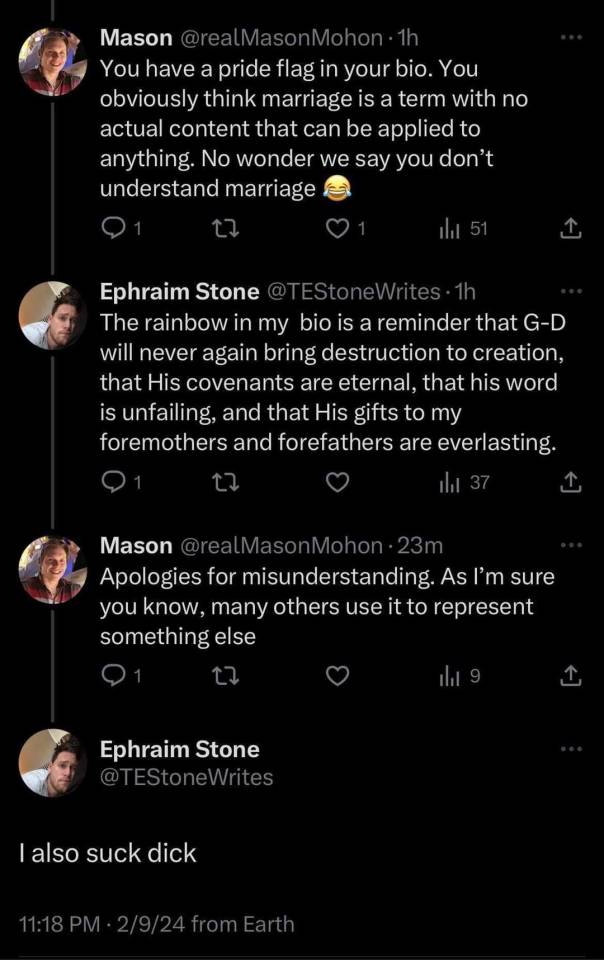
104K notes
·
View notes
Text

SAINTS DECEMBER 26
ST. STEPHEN, FIRST MARTYR St. Stephen Stephen's name means "crown," and he was the first disciple of Jesus to receive the martyr's crown. Stephen was a deacon in the early Christian Church. Saint Stephen is known as the “Proto-Martyr,” insofar as he was the first of the early disciples to shed his blood for Christ. The account of his martyrdom by stoning is related in the Acts of the Apostles. Because of the manner of his death, he is recognized as patron of stoneworkers and masons. Dec.26
St. Amaethlu, 6th century. Founder and hermit. Arnaethlu also called Maethlu, lived in Wales. A church in Anglesey is named after him as the founder.
St. Pope Dionysius Roman Catholic Priest and Pope. Dionysius died in Rome, was the first pope not listed as a martyr, and was buried in the cemetery of Callistus. Dec.26
St. Vincentia Maria Lopez Y Vicuna, Roman Catholic Nun and foundress of Daughters of Mary Immaculate for Domestic Service, a religious congregation dedicated to the ministering to working girls. Dec.26
0 notes
Text
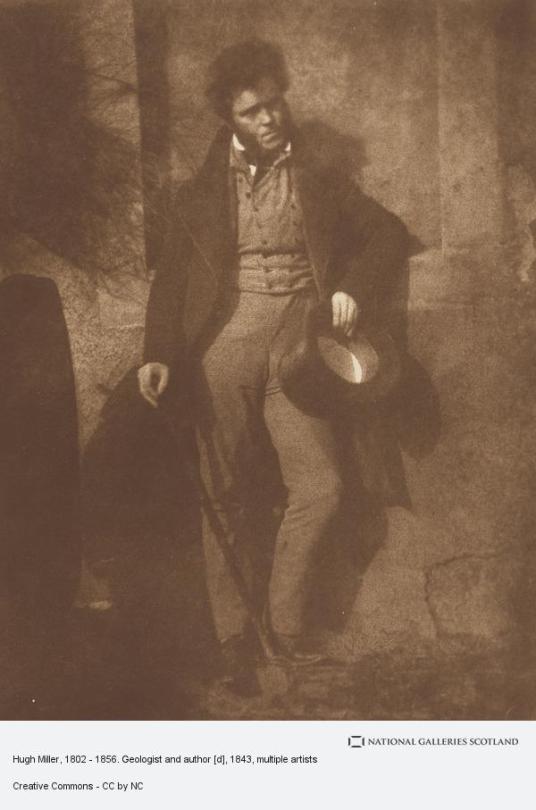

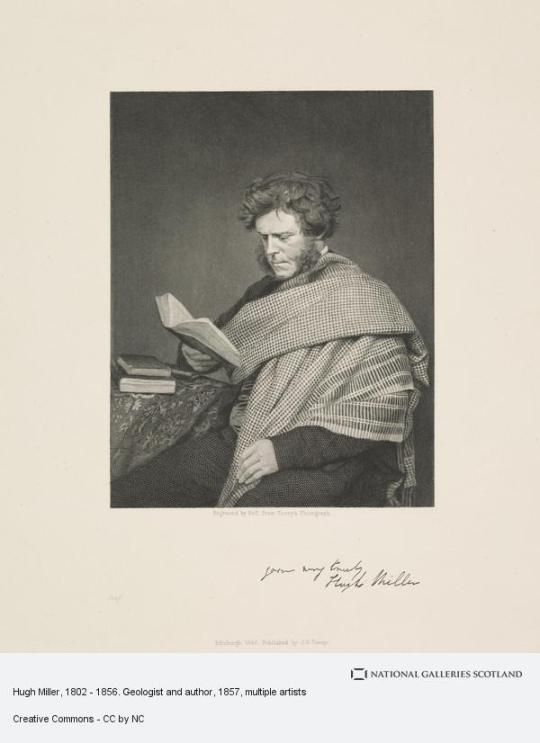
On December 24th 1856 the writer and geologist Hugh Miller “The Highlander who changed the world” died.
The death of Hugh Miller saddens me. On Christmas Eve, after reading some poems to his children and sending them to bed, Miller wrote a suicide note to his wife Lydia and shot a bullet through his chest, muffling the sound. Lydia discovered the body the next morning.
He may not be the best known Scot but Miller was a man of many talents, fossil hunter, folklorist, Christian, stonemason, geologist, newspaper editor, social justice campaigner, he was one of the great Scots of the 19th century.
Unlike other famous Scottish geologists like Hutton and Lyell, Miller was self taught.
Miller was orphaned after his father was lost at sea, he was educated at the local parish school and was said to have been an avid reader but also a habitual truant! After school he trained as a stone mason and it was while working in the quarries that his interest in geology began. He also started to write articles for the Inverness Courier. His book, Scenes and Legends of the North of Scotland is considered a classic, collected from the Cromarty firesides of friends and family it was inspired by two of Scotland’s literary greats Walter Scott and James Hogg.
Much of his writing was based upon his personal experiences of travelling around Scotland and northern England where he observed closely the homes and ways of life of Scottish crofters and the effects of the Highland Clearances. He also became heavily involved in religion and was involved in the fledgling days of the “Wee Free” editing their newspaper The Witness.
He also wrote on Geology and made many important original contributions to this field, discovering fossils of sea scorpions (eurypterids) from the Silurian, and fishes from the Old Red Sandstone (Devonian) rocks, on the coast near Cromarty, together with plants from the Devonian and Carboniferous periods.
His fish specimens proved of great interest to Louis Agassiz, the Swiss geologist who had become a world authority on fossil fishes. He also found many marine invertebrate fossils from the upper Jurassic rocks, also around Cromarty. Many of his fossils were drawn by him and presented in his Testimony of the Rocks, and in lectures that he gave to the Edinburgh Philosophical Institute,
His fossil collection of over 6,000 specimens formed the founding core of what is today’s Scottish national collection in the National Museums of Scotland.
For most of 1856, Miller suffered severe headaches and mental distress, and the most probable diagnosis is of psychotic depression. Victorian medicine did not help. He feared that he might harm his wife or children because of persecutory delusions.
Hugh Miller left the following note for his wife;
“Dearest Lydia, I must have walked, and a fearful dream rises upon me. I cannot bear the horrible thought. God and Father of the Lord Jesus Christ, have mercy upon me.”
Speculations about Miller’s reasons immediately rose. Upon request of his pastor, physicians conducted an examination of his brain, which showed a “diseased appearance.” The final judgment was that the suicide had been committed “under the impulse of insanity.”
He had not been well for a while. He had complained to his doctor that his brain was “giving way,” and had reported terrible nightmares that left him “trembling all over, and quite confused.” He had also reported sharp pains, like “an electric shock,” passing through his brain and leaving a burning sensation on top of his head. Because of these physical symptoms and the visible appearance of a “diseased brain,” some have suggested a brain tumour. Whatever it was, it was fairly sudden and unpredicted. As most illnesses of the brain, it was also largely unexplainable.
But people want explanations. Some blamed his mother, who told him stories about frightening Gaelic spirits. Some suggested he could not deal with the apparent contradictions between his faith and his geological studies. Interestingly, this second theory is still strong today. Yet, its proponents, like myself, don’t know Hugh Miller. He was never afraid of the truth, nor of the questions and challenges that led to its discovery.
In truth we will never know why he took his own life, like many suicides it is left unexplained, I suggest you have a look at the page below, “ The final days of Hugh Miller”
14 notes
·
View notes
Text
List the Greatest Male British Singers of All Time Based on Their Lyrics and Singing
List the Greatest Male British Singers of All Time Based on Their Lyrics and Singing Freddie Mercury (Queen)David Bowie Thom Yorke (Radiohead,Solo and The Smile)Ed Sheeran Robert Plant (Former Zeppelin and Solo)John Lennon Paul McCartney George HarrisonRingo StarMick Jagger (Stones)KinksCreamDavid Gilmour and Roger Waters (Floyd)Ozzy Osbourne (Former Sabbath and Solo)Lemmy (Motörhead)Rob Halford (Judas Priest)Joe Strummer (Clash)Paul Weller (Jam)Ian Gillan (Deep Purple)Moody BluesPeter Gabriel and Phil Collins (Former Genesis and Solo)Sting (Former Police and Solo)Dire StraitsElton JohnElvis CostelloDave GahanTears for FearsHuman LeagueNew OrderGeorge MichaelDuran DuranThompson TwinsPet Shop BoysSpandau BalletJim Kerr (Simple Minds)Morrissey (Former Smiths and Solo)Peter Murphy (Bauhaus)Richard Butler (Psychedelic Furs)Jesus and Mary ChainBruce Dickinson (Iron Maiden)Joe Elliott (Def Leppard)Billy IdolLiam Gallagher (Oasis and Solo)Pulp Brett Anderson (Suede)SupergrassGavin Rossdale (Bush)Brian Molko (Placebo)SlowdiveStereophonicsMatt Bellamy (Muse)Chris Martin (Coldplay)KeaneGary Lightbody (Snow Patrol)Biffy ClyroFratellisLibertinesBloc PartyKooks Kasabian Alex Turner (Arctic Monkeys)Conor Mason (NBT)Alt JMatthew Tuck (BFMV)Oli Skyes (BMTH)Danny Worsnop (Asking Alexandria)StrutsTwo Door Cinema ClubRoyal BloodBlossomsCatfish and the BottlemenFoalsIdlesBastille Glass AnimalsHarry Styles ZaynLouis Tomlinson VampsRag n BoneYUNGBLUD Submitted December 18, 2024 at 09:36AM by Amber_Flowers_133 https://ift.tt/SLEPK8X via /r/Music
0 notes